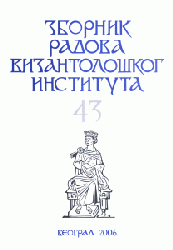Zamak u srpskim zemljama poznog srednjeg veka
The Castle in Late Medieval Serbian Lands
Author(s): Marko PopovićSubject(s): History
Published by: Vizantološki institut SANU
Keywords: castle; Serbia; medieval Serbian lands; medieval town;
Summary/Abstract: Studies of fortifications in the medieval Serbian lands have not paid sufficient attention to typological classification of structural remains, which in turn is clearly reflected on terminological level. Such defensive strongholds have been almost invariably designated by the term srednjovekovni grad (medieval town), which, generally speaking, should not create any confusion. In the Old Serbian and other Slavic languages the term grad originally denoted a fortified enclosure regardless of its size or the complexity of its layout. With the growth of settlements, however, the term became extended to include fortified outlying wards or urbanized areas, and subsequently even unfortified urban settlements, whereby it acquired its modern meaning. Unfortunately, the term in its thus modified meaning is often used in the Serbian language to denote medieval fortifications; if unaccompanied by additional clarification, such usage gives rise to confusion and misinterpretation. The first step towards solving this problem would be a typological classification of medieval fortifications according to structure and function, and both of fortified complexes and of their constituent parts, which in turn calls for a precise use of terminology. With no pretensions to a comprehensive solution to this complex problem, which obviously requires a separate study, the author of this paper seeks to characterize, in spatial and functional terms, the type of medieval Serbian fortifications, i.e. part of fortifications, that may be subsumed under the term zamak, corresponding to the English castle; French chateau; German Schloss, but also Burg; Italian and Spanish castello; Russian zamok; meaning the fortified residence of the monarch or a lord. The author looks at definitions of the castle in west-European architecture, finds that this type of fortified residences does not occur in the lands of the Byzantine commonwealth before the 13th-14th centuries, i.e. before the capture of Constantinople by crusaders, offers a comparative analysis of similar forms, and goes on to discuss the emergence of castle-type fortifications in medieval Serbian lands.The fortifications in Serbian lands dated to early periods of the late Middle Ages mostly belong to the Byzantine legacy of the llth-12th centuries. The 13th and early 14th centuries did not witness any new fortifications except in frontier areas. In that period not even the residences of the Serbian kings and lords were fortified, which indicates a general sense of security, especially from an external enemy...
Journal: Зборник радова Византолошког института
- Issue Year: 2006
- Issue No: 43
- Page Range: 189-209
- Page Count: 19
- Language: Serbian

